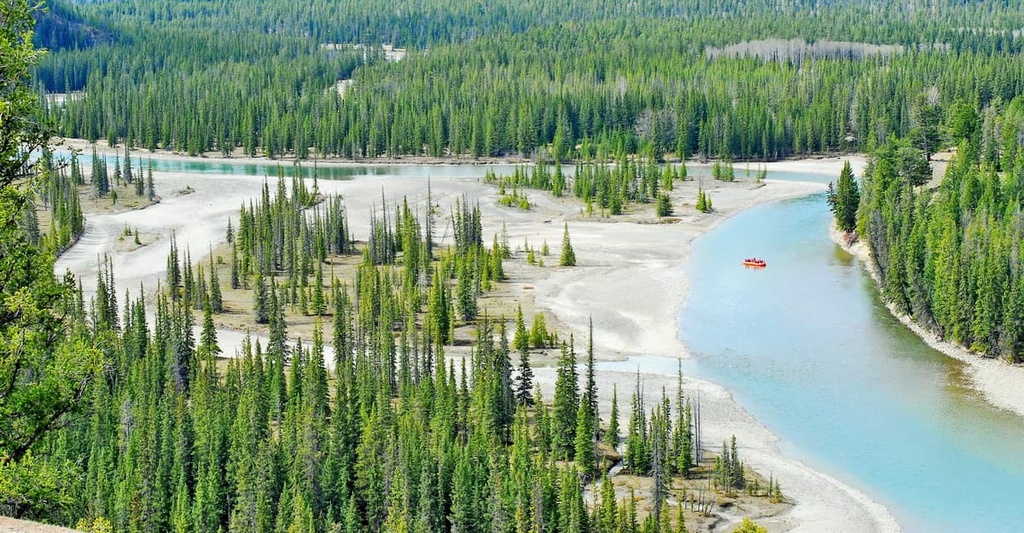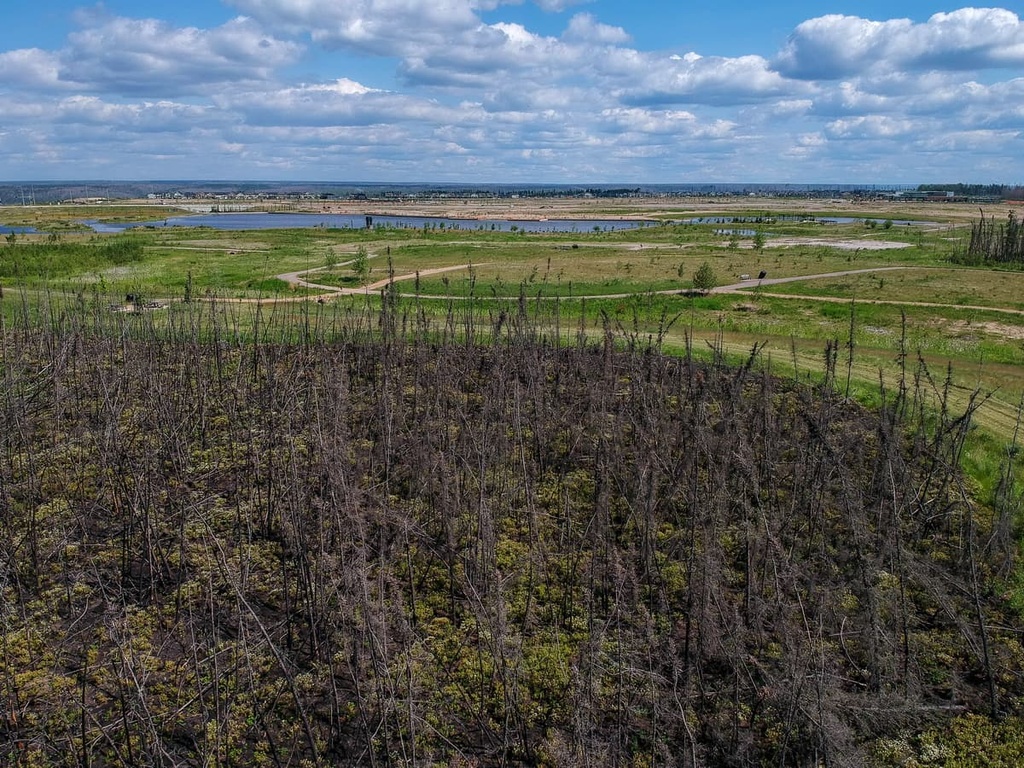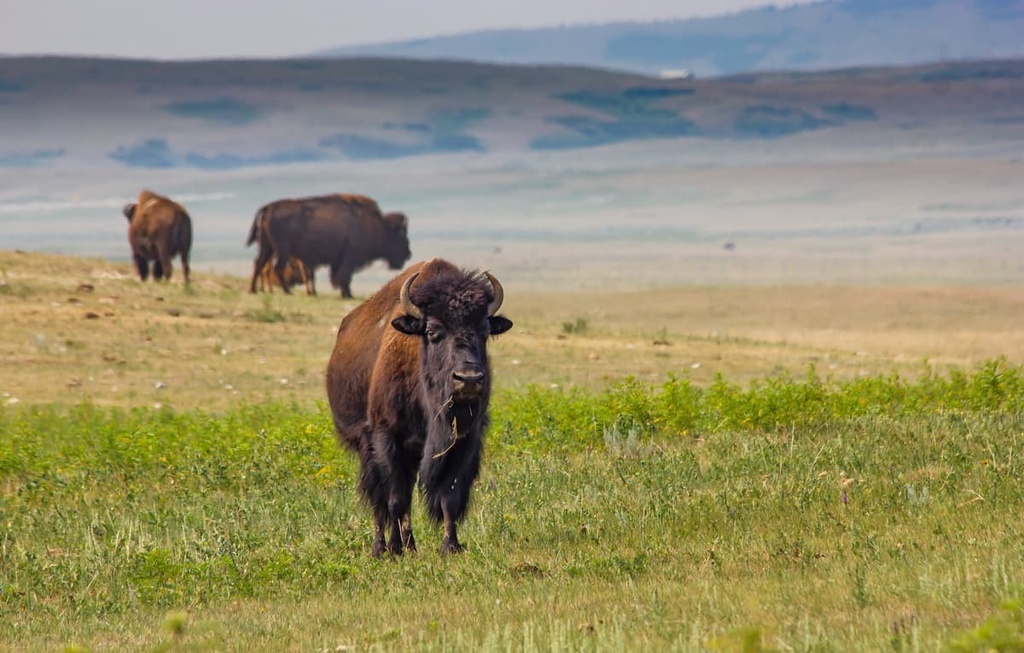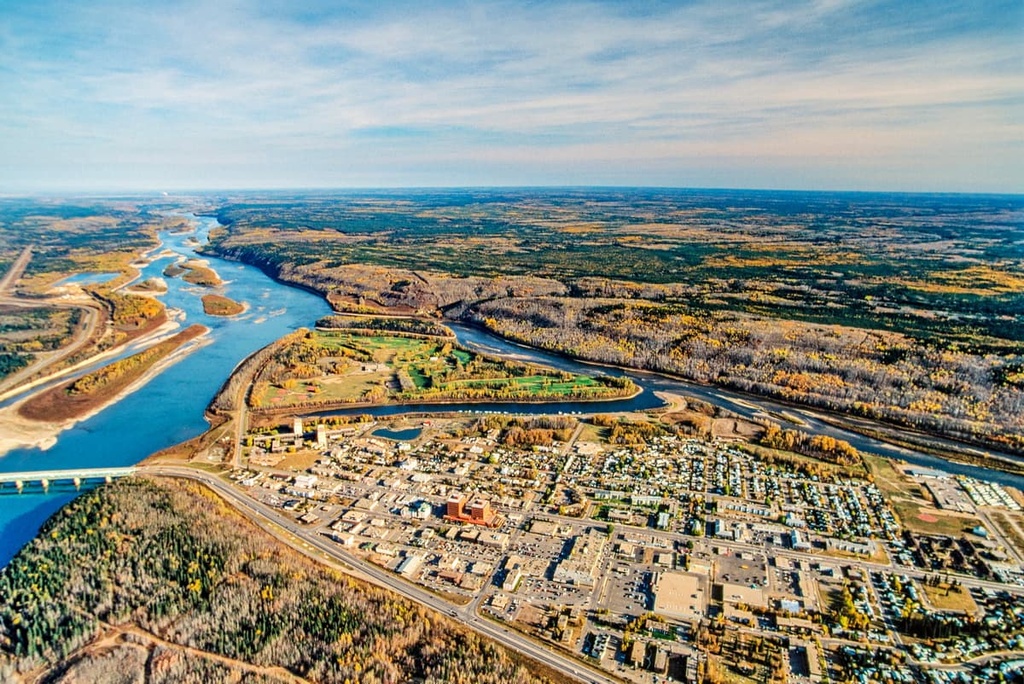Get PeakVisor App
Sign In
Search by GPS coordinates
- Latitude
- ° ' ''
- Longitude
- ° ' ''
- Units of Length

Yes
Cancel
Share ×

Scan the QR code and open PeakVisor on your phone
❤ Wishlist ×
Choose
Delete
Birch Mountains Wildland Provincial Park is a protected area located in northern Alberta, Canada that’s home to one of the most diverse intact hill systems in the Canadian boreal forests. The park is characterized by relatively flat highland, old growth forests, and wetlands that create diverse habitats for wildlife. Within the park, the landscape has an average elevation of 700 m (2,297 ft). The park’s highest point has about 200 m (650 ft) of prominence over the surrounding terrain.

Located among the boreal forests of northern Alberta, Canada, Birch Mountains Wildland Provincial Park is a protected area that encompasses 1,445 square kilometers (558 square miles) of hills, wetlands, shallow lakes, and mixed wood stands of trees. It is situated on relatively flat highlands compared to the surrounding lowlands of the Athabasca River Valley.
The park is located in the Regional Municipality of Wood Buffalo in the northeastern part of the province. It is located to the west of the community of Fort McKay and the city of Fort McMurray, but there is no maintained road access to the park. During the summer months, the park is only accessible via bush plane, but during the winter, there is snowmobile access to the area.
Birch Mountains Wildland Provincial Park is part of one of the largest contiguous areas of protected boreal forest in the world. In addition to Birch Mountains, the following parks and protected areas are part of this massive protected area of boreal forest:
For significant parts of its geological history, Alberta was covered in a shallow sea. Throughout the Paleozoic and early Mesozoic, marine sediments were deposited into thick layers over what is now northern alberta. However, during the Cretaceous, the mountain building events in the west caused the deposition of vast amounts of mud, sand, and silt across Alberta.
During the formation of the Western Cordillera, which includes the Rocky Mountains, a new Continental Divide was formed that caused the sea to start draining to the east. Additionally, new rivers were created that drained towards the north and the east, eroding vast amounts of the surface layers of rock in the process.
Following these mountain building events, the Pleistocene ushered in a period of extensive glaciation. These ice sheets originated in the Arctic and extended across Canada. In the western mountains, these glaciers then flowed eastward toward the prairies and westward over the edge of the continent.

As the ice sheets and glaciers melted, they left behind layers of fine glacial till that covered the ground. The Birch Mountains are the remnants of the Alberta Plateau and they feature deposits of glacial till. The glacial till has created many formations across the park, such as eskers, drumlins, moraines, slump and seepage areas, and permafrost features.
An interesting note on the geology of the region is that there are many kimberlite pipes that were discovered in the Birch Mountains to the southwest of Birch Mountains Wildland Provincial Park. The volcanic activity that created the kimberlite pipes occurred during the late Cretaceous, when North America was split by a shallow sea that covered Alberta.
Birch Mountains Wildland Provincial Park is ecologically significant because it contains a highland region within the vast boreal forest of northern Alberta. As part of the Boreal Forest Natural Region, the park has significant areas of bogs in addition to the mixed wood forests.
The forests of the Birch Mountains are a mix of lodgepole pine, black spruce, and hybrid lodgepole-jack pine. The forests cover the majority of the area and the rest is covered by shallow lakes, and bogs. Cloudberry, bog berry, Labrador tea, and sphagnum moss are the typical understory and ground cover in the park. In 2004, quillwort, a rare aquatic plant, was discovered in the park, too.
This unique landscape is home to diverse and abundant wildlife of birds, fish, and mammals. White pelicans, bald eagles, loons, terns, cormorants, black-bellied plovers, ruddy turnstones, peregrine falcons, warblers, Franklin gulls, and Bonaparte gulls. The park is also home to a California gull colony.
Birch Mountains Wildland Provincial Park is home to one of Canada’s only free-roaming wood bison herds outside of Wood Buffalo National Park. The hills and wetlands are also home to wolves, coyotes, moose, white tailed deer, and boreal woodland caribou. The lakes are inhabited by Arctic grayling, goldeye, lake whitefish, mountain whitefish, northern pike, and walleye.

As the ice sheets of the Pleistocene melted about 14,000 years ago, an ice-free corridor began to open between the northern areas of Alaska, Yukon, and Alberta, connecting them to what is now Montana in the US.
Initially, the corridor had a steppe-like ecology of open grasslands. This was conducive to the migration of the ancient fauna, which included mammoths, giant bison, horses, camels, elk, and sheep.
Approximately 14,000 to 11,000 years ago, people likely first migrated into or through the Birch Mountains. However, the boreal forest that now dominates the region didn’t start to grow until much later. There are many archaeological and cultural sites located along the Athabasca River and the shores of the lakes in Birch Mountains Wildland Provincial Park.
Through the uncovering of projectile points and other artifacts, archaeologists have attempted to piece together the human history of the Birch Mountains. From their findings, it appears as though there has been a relatively constant human habitation in the Birch Mountains and their associated lowlands along the Athabasca River Valley for thousands of years.
Furthermore, cultural knowledge and archaeological evidence suggests that the first inhabitants of the region were influenced by Indigenous cultures in northern British Columbia, Alaska, and Yukon. It appears that the Indigenous peoples of what is now northern Alberta thrived and traded goods and knowledge with the many other Indigenous communities around them.
Northern Alberta is home to several distinct First Nations. Birch Mountains Wildland Provincial Park is the traditional territory of the Cree, Dene Suline, and Dane-zaa First Nations, who have all lived in the region since time immemorial.
Peter Pond was one of the first people of European descent to make contact with the First Nations of the Birch Mountains. He visited the region in 1778, bringing with him the international fur trade.
As the fur traders entered the region, some traders attempted to learn the seasonal and regional patterns of the First Nations of what is now northern Alberta. Some guides, such as Paul St. Germain used traditional techniques of gathering materials to build birch bark canoes and winter hunts to survive in the remote Birch Mountains.
Before the era of the international fur trade, many First Nations in the region lived a nomadic lifestyle. Small family groups traveled seasonal rounds of hunting and gathering in both the highlands and the lowlands.
Most of the archaeological sites in the region are found in the lowlands in the Athabasca River valley; however, there are some sites in the Birch Mountains and specifically in Birch Mountains Wildland Provincial Park.
By the 1830s, many Cree First Nations stopped their seasonal hunts in the Birch Mountains due to diminishing game resources. However, there are currently commercial hunting lodges that operate successfully in Birch Mountains Wildland Provincial Park.
Birch Mountains Wildland Provincial Park was established under the Provincial Parks Act and it was formally designated in December of 2000. It was expanded to its current size in 2018 as part of the creation and expansion of new protected areas in northern Alberta.
The remote wilderness of Birch Mountains Wildland Provincial Park offers many activities for visitors to enjoy. Some of the activities that are available in the park include backcountry camping, canoeing, kayaking, fishing, hiking, hunting, wildlife and bird viewing, and snowmobile and OHV use.
There are no roads that enter the park. Summer entry is limited to fly-in transportation, but there are winter roads that lead to snowmobile trails that provide access to the park. There are no official hiking trails in the park; however, there are designated trails for snowmobiles and OHV use.
Likely the most popular reason to visit the park is to fish in one of the lakes, where you may find yourself with a trophy-sized catch. The lakes in the park are popular for their lake trout, northern pike, and Arctic grayling. While there are two camps in the park, the Island Lake Lodge is owned by the Fort McKay Métis Nation and is for their sole use.
The Namur Lake Lodge is a public lodge located in the park that has been offering fly-in fishing experiences for the past 30 years. While there are no other public lodges in the park, the other lakes are also full of massive fish. They are accessible by plane or snowmobile in the winter for ice fishing.
Northern Alberta is sparsely populated and Birch Mountains Wildland Provincial Park is remote, even for northern Alberta. While there are some small communities near the park, most visitors fly in from Fort McMurray. Visitors of the park can choose to visit the region’s commercial lodge or camp in the incredible backcountry of the park.
The following are the nearby cities and accommodation options for visitors to Birch Mountains Wildland Provincial Park:
Located on the shores of Namur Lake, the Namur Lake Lodge has been offering fly-in fishing excursions to visitors for decades. The lodge is currently the only commercial lodge in the park, with flights that originate from Fort McMurray.
Open from June to September each year, the lodge has bunk cabins for guests, hot showers, and flush toilets. Aside from fishing, there are ample opportunities for wildlife viewing near the lodge. A highlight of staying at the lodge includes being able to see one of the few nesting sites for white pelicans, which is located at Namur Lake.
There are also some nature trails that originate from the lodge to help you enjoy the pristine wilderness of the Birch Mountains. While hiking or fishing around the lodge, you may be fortunate enough to see red fox otters, fishers, pine marten, wolverines, woodland caribou, or wolves, all of which are all native to the park.
Known for its oil sands industry, the city of Fort McMurray is located about 120 km (72 miles) to the southeast of Birch Mountains Wildland Provincial Park. From the city, you can charter a flight to the lodge at Namur Lake or to one of the other lakes in the park.

The oil sands around what is now Fort McMurray have been known by the Indigenous peoples of the region for countless generations. In fact, the thick surface oil of the oil sands was traditionally used to waterproof birch bark canoes.
Starting in the twentieth century, companies began experimenting with methods to extract the oil from the sand for further refining. As oil prices increased, major projects were built near the city, which serves as the industrial, commercial, and service hub for northeast Alberta.
Within the city there are many hiking trails. These include the animal themed interconnected Fox, Bear, Wolf, Deer, Moose trails as well as other trails located near the community of Thickwood. Additional recreational opportunities can be found at parks near the city, which include Gregoire Lake, Stony Mountain, Grand Rapids, and Gipsy Lake.
Explore Birch Mountains Wildland Provincial Park with the PeakVisor 3D Map and identify its summits.




